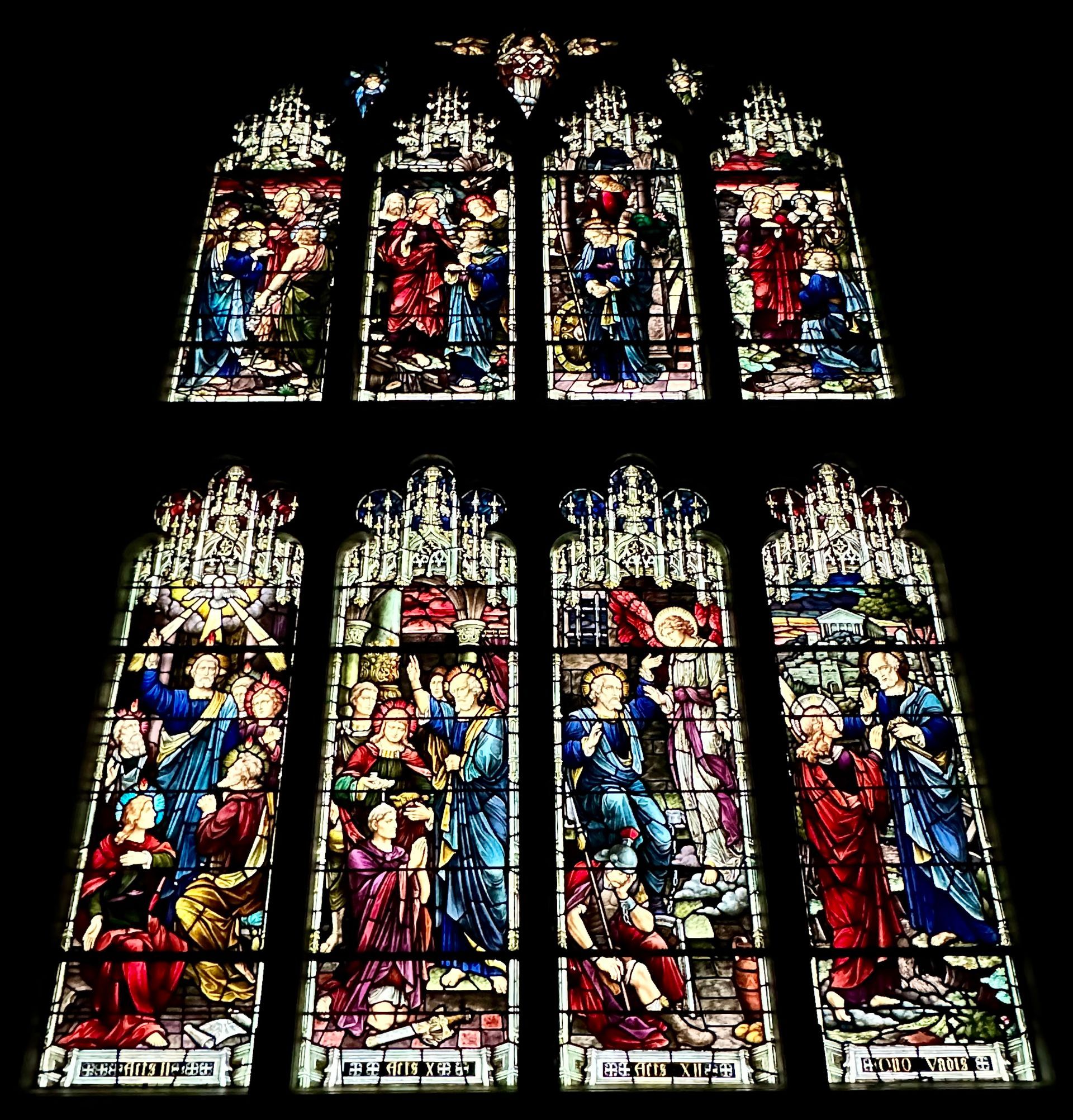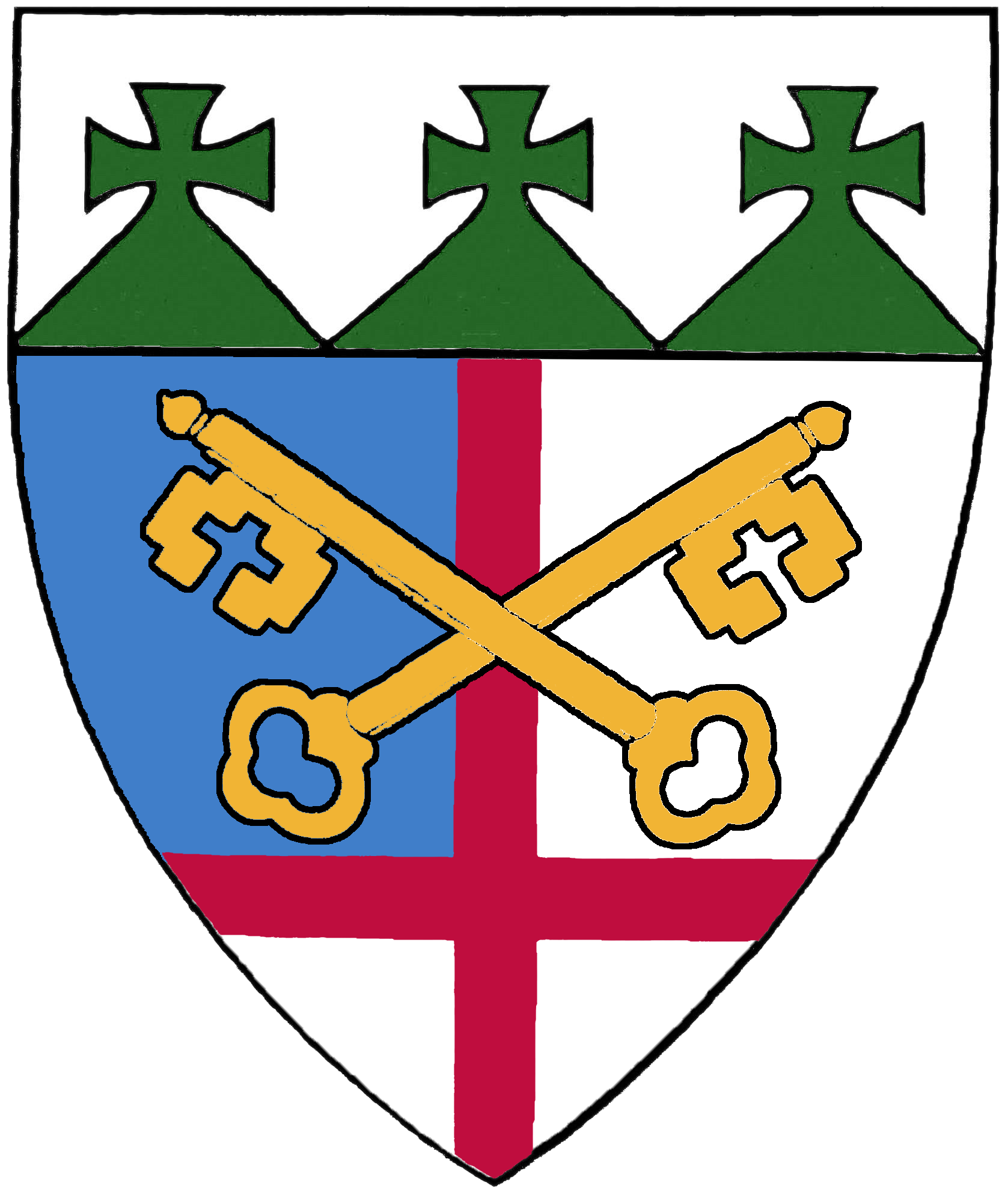The Centennial (St. Peter) Window
Narthex (Heaton, Butler & Bayne 1934)

The eight panels representing incidents in the life of St. Peter were given in memory of John Gelson Floyd by the Rev Thornton Floyd Turner (legacy), Clara and Barrett White Hall by Mrs. Charles White Hall (legacy), Charles Squires Hutchins by Mrs. Charles Squires Hutchins, Harrison Isaiah Norton and Annie Boyd Norton by their daughter Mrs. Francis H. Englehart, and Katherine Eliza Root by Mrs. William H. Root and Mrs. O.W. Kohn.
The uppermost figure in this group of memorial windows is an Angel bearing a shield displaying the keys which are St. Peter’s identifying insignia, thereby proclaiming this to be the St. Peter window; each panel depicts an event in St. Peter’s life. A detail which seems particularly interesting and appropriate is the artist’s choice of color for the robes of our Lord. You will note that it is the Royal Purple – for the King of Kings – while the red cloak, or mantle, worn over the robe suggests His martyrdom – His crucifixion.
Upper Section
First Panel - It will be remembered that St. John has baptized Jesus, not knowing who he was, until the Spirit “descended from heaven like a dove and abode upon him.” So it was that later when St. John, with two of his disciples, saw Jesus approaching, he said “Behold the Lamb of God.” One of the two that heard John speak was Andrew who promptly sought out his brother Simon Peter – telling him that they had found the Christ – and returning together they followed Jesus becoming His first apostles. So in the first panel we see Jesus, St. John, St. Peter and St. Andrew.
The Second Panel depicts a wharf with a fisherman’s net hanging over it and a boat in the background with a lantern at its helm and a young man aboard the boat indicating considerable activity. It calls to mind the incidents following Jesus’ departure into Galilee, after leaving Nazareth, when He came to dwell in Capernaum on the sea coast. It was there, walking by the Sea of Galilee, that He saw the brothers “Simon called Peter and Andrew his brother casting a net into the sea,” as any fisherman would, carrying on their business. It was then that Jesus called to them “Follow me and I will make you fishers of men.” The other figures are apparently those of James, the son of Zebedee, and John, his brother, (still in the boat) and old Zebedee himself, for they had been in the ship when Jesus called to them also to follow Him. This is in brief St. Matthew’s story of the calling of St. Peter.
The Third Panel portrays what was probably the most tragic and heartbreaking event in St. Peter’s life – his denial of our Lord. Though the window tells little of the story – actually only the end – we know from that end, that it records the events leading up to the last supper “in the upper room” and our Lord’s statements that one of the twelve would betray Him and that before the cock crew Peter would deny Him thrice. It reminds us of His prayers on the Mount of Olives just before Judas appeared with the multitude to betray Him with a kiss, The window does depict the house of the high priest where Jesus was taken, under heavy guard, and where Peter had followed "afar off.” The two soldiers with their spears indicate that Jesus was under guard awaiting trial. Three times was Peter pointed out as being with Jesus - one of his followers – and each time he denied knowing Him, but when the cock crew the Lord turned and looked at Peter and Peter remembering what the Lord had said “went out and wept bitterly.” And so we see Peter leaving the house of the high priest sorrowing.
The fourth panel portrays the risen Lord restoring Peter – this being the third time that Jesus showed himself to his disciples after He had risen from the dead. Upon this occasion He commanded St. Peter to “feed my sheep.”
Lower Section
Panel One brings us to the day of Pentecost when “they (the apostles) were all with one accord in one place” – Matthias having been chosen to fill the place in that group once held by Judas. Here we are told there came a sound from heaven as of a mighty wind and tongues of fire appeared and “sat upon each of them” and they were filled with the Holy Ghost and began to speak “with other tongues as the Spirit gave them utterance.” Dwelling in Jerusalem at that time were devout men of every nation. When they heard this amazing news, the multitude assembled and marveled that each man heard the Apostles speak in his own language. Some scoffed and accused the apostles of being full of new wine but Peter, again the central figure, disabused their minds in no uncertain terms.
The Second Panel tells the story of Cornelius of Cesarea whose title of Centurion denotes that he was an army officer, a Captain in command of a hundred men. He was known to be a devout and God-fearing man. This is a fascinating story and chapter ten of the Acts should be read by al to appreciate this window fully, but in brief an angel appeared to Cornelius commanding him to send for St. Peter who would be found in Joppa, and who would tell him what he ought to do. Cornelius promptly sent two of his servants and a “devout soldier” to find Peter, requesting him to return with them to the home of Cornelius the Centurion. In the meantime Peter had seen a vision which disturbed and puzzled him greatly until Cornelius told Peter of his vision and it then became clear that it was a command from God that the Christian Jews should not exclude Gentiles from membership in the Christian community. At this point, Peter remarked, “Of a truth I perceive that God is no respecter of persons,” and that he had been called by God to preach the gospel of Jesus Christ to Cornelius and his company. While Peter was preaching thus the Holy Ghost fell upon all of them which “heard the word,” amazing both Peter and those who had come with him. Peter, forthwith, commanded that these Gentiles be baptized.
The Third Panel of the Lower Group portrays the familiar and ever thrilling deliverance of St. Peter from the prison into which Herod had cast him and where, to please the Jews, he would have been put to death after “the days of unleavened bread.” Herod had already put St. James to death and to make sure that St. Peter did not escape had him bound by heavy chains to his guard. There were guards also at the doors of the prison and at the iron gates leading into the city. In answer to the prayers of “the church” the angel of the Lord was sent to release Peter. While the guards slept, the angel smote the chains so that they fell away from Peter’s arms and he was led through doors and gates that opened to them of their own accord. Peter at first thought he had seen a vision but, finding himself alone and free in the city, sought out his friends and after telling them of the miracle departed into another city where Herod could not find him.
The Final Panel shows St. Peter as he seems about to take leave of Jesus and move toward a hillside covered with ancient tombs. One can almost hear him ask “Whither goest thou” as he ponders the age old question of life beyond the grave. And one might go even further in imagining Jesus’ reply – “In my father’s house are many mansions —" “I go to prepare a place for you.”
The St. Peter’s Window was dedicated on June 28th, 1934 when the Diocesan Convention met at St. Peter’s to celebrate the one hundredth anniversary of the founding of the Parish. At the evening service the window was dedicated by the Bishop of Vermont, assisted the Rector, the Rev. Norman P. Dare, and three former Rectors, to “Communicants of the Past and to the years that lie ahead.”

